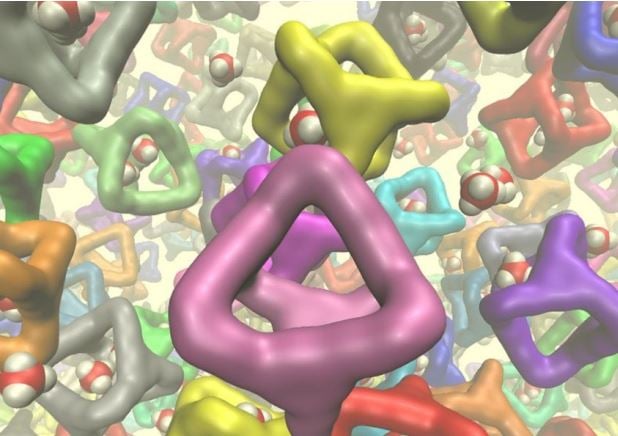An incredible porous liquid has been created by scientists at Queen’s University Belfast and other research centres, which they claim has the potential for a huge range of new technologies, including ‘carbon capture’, i.e. the capture of the greenhouse gas carbon dioxide (CO2) released by burning fossil fuels.
Scientists from the School of Chemistry and Chemical Engineering at Queen’s, together with other researchers from the UK, France, Argentina and Germany, explain in the academic journal Nature that they have invented a new liquid that can dissolve gas – and in unusually large amounts.
The gas is absorbed into ‘holes’ in the newly-created liquid, they say.
 Image of the news porous liquid that can dissolve huge amounts of gas. (Image: Queen’s University Belfast)
Image of the news porous liquid that can dissolve huge amounts of gas. (Image: Queen’s University Belfast)
Preventing CO2 from entering the atmosphere
The three-year scientific project will probably pave the way for several more greener and more efficient chemical processes, the authors explain, including ultimately the trapping of CO2 from major sources.
Carbon dioxide emissions from fossil-fuel power plants could be absorbed by the liquid, thus preventing it from entering the atmosphere and contributing towards global warming.
Mechanochemical synthesis researcher, Professor Stuart James, of Queen’s School of Chemistry and Chemical Engineering, explained:
“Materials which contain permanent holes, or pores, are technologically important. They are used for manufacturing a range of products from plastic bottles to petrol. However, until recently, these porous materials have been solids. What we have done is to design a special liquid from the ‘bottom-up’ – we designed the shapes of the molecules which make up the liquid so that the liquid could not fill up all the space.”
 If this porous liquid can absorb huge quantities of CO2, could it be part of the solution to our global warming problem?
If this porous liquid can absorb huge quantities of CO2, could it be part of the solution to our global warming problem?
“Because of the empty holes we then had in the liquid, we found that it was able to dissolve unusually large amounts of gas. These first experiments are what is needed to understand this new type of material, and the results point to interesting long-term applications which rely on dissolution of gases.”
The scientists said further research is required in order to find applications for these porous liquids, which should eventually lead to new or improved chemical processes.
Liquids with holes absorb gases
Prof. James added:
“At the very least, we have managed to demonstrate a very new principle – that by creating holes in liquids we can dramatically increase the amount of gas they can dissolve. These remarkable properties suggest interesting applications in the long term.”
The research was led by Queen’s University Belfast, and also involved scientists from the University of Liverpool, the Universidad Nacional de Cuyo, Argentina, the Universität Kiel, Germany, and the Université Blaise Pascal, France.
The study was financed by the Engineering Physical Science Research Council (the UK’s main agency for funding research in engineering and the physical sciences) and the Leverhulme Trust.
Citation: “Liquids with permanent porosity,” Nicola Giri, Mario G. Del Pópolo, Margarida F. Costa Gomes, Gavin Melaugh, Laure Pison, Rebecca L. Greenaway, Klaus Rätzke, Tönjes Koschine, Andrew I. Cooper & Stuart L. James. Nature 527, 216–220. 12 November, 2015. DOI: 10.1038/nature16072.
Video – Porous liquid
This is a supplementary video from the study carried out by Prof. James and colleagues.
